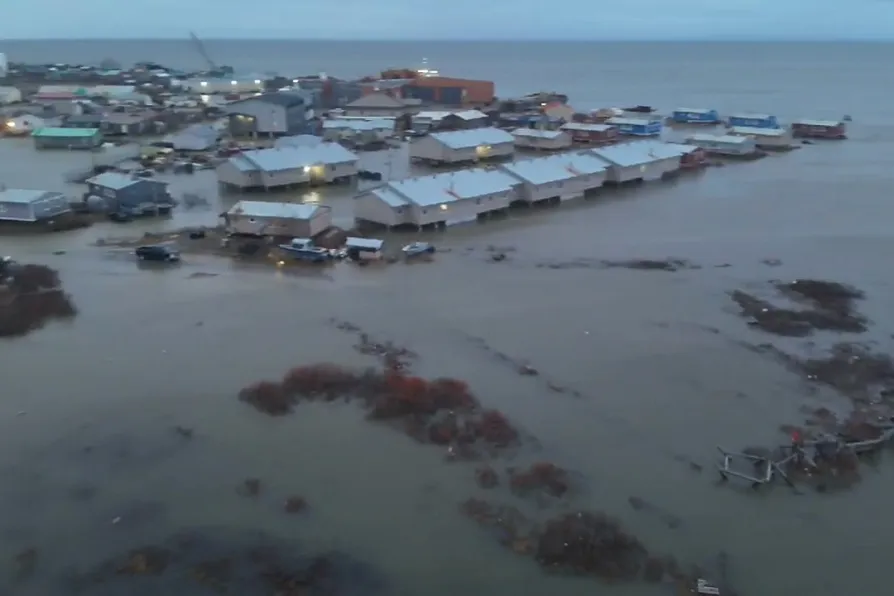
 In this aerial photo provided by the Alaska Department of Transportation and Public Facilities, the city of Kotzebue, Alaska, experiences flooding, October 8, 2025. Photo: Alaska Department of Transportation and Public Facilities via AP
In this aerial photo provided by the Alaska Department of Transportation and Public Facilities, the city of Kotzebue, Alaska, experiences flooding, October 8, 2025. Photo: Alaska Department of Transportation and Public Facilities via AP
MORE rain and wind were forecast along the Alaskan coast today, where Typhoon Halong decimated two tiny indigenous villages, leaving 1,500 people displaced.
The storm brought powerful winds and waves to low-lying communities on the Yukon-Kuskokwim Delta, nearly 500 miles from Anchorage.
At least one person was killed, and two others remain missing, officials said.
The Coast Guard rescued 24 people after their homes floated out to sea, while hundreds sought refuge in schools, including one with no working toilets.
The hardest-hit communities included Kipnuk, population 715, and Kwigillingok, population 380.
They are off the state’s main road system and are reachable only by water or air at this time of year.
“It’s catastrophic in Kipnuk. Let’s not paint any other picture,” Mark Roberts of the state emergency management division said.
“We are doing everything we can to continue to support that community, but it is as bad as you can think.”
Resident Brea Paul said she saw about 20 homes float away, saying: “Some houses would blink their phone lights at us like they were asking for help, but we couldn’t even do anything.”
In Kwigillingok, authorities on Monday night called off the search for two men whose home floated away.
Every home in the village was damaged, and many were swept from their foundations.
Power systems were flooded in Napakiak, and severe erosion was reported in Toksook Bay.
In Nightmute, officials said fuel drums were reported floating in the community, and there was a scent of fuel in the air and a sheen on the water.
The National Guard was activated to help with the emergency response, and crews were trying to take advantage of any breaks in the weather to fly in food, water, generators and communication equipment.
“Indigenous communities in Alaska are resilient,” said Rick Thoman, a climate specialist at the University of Alaska Fairbanks.
“But, you know, when you have an entire community where effectively every house is damaged and many of them will be uninhabitable with winter knocking at the door now, there’s only so much that any individual or any small community can do.”
Mr Thoman said the storm was likely fuelled by the warm surface waters of the Pacific Ocean, which has been heating up because of human-caused climate change and making storms more intense.
Another storm, Typhoon Merbok, caused damage across a massive swath of western Alaska three years ago.
It comes as the UN’s World Meteorological Organisation (WMO) warned today that carbon dioxide levels in the atmosphere hit new record highs last year, and heat trapped by such greenhouse gases is “turbo-charging” the Earth’s climate and causing more extreme weather.
The UN weather agency said in its latest bulletin on greenhouse gases that C02 growth rates have now tripled since the 1960s, and emissions from human activities and more wildfires helped fan a “vicious climate cycle.”
It said the increase in the global average concentration of carbon dioxide from 2023 to 2024 amounted to the highest annual level of any year since measurements began in 1957.
WMO deputy secretary-general Ko Barrett said: “Reducing emissions is therefore essential not just for our climate but also for our economic security and community well-being.”
The increase in 2024 is setting the planet on track for more long-term temperature increase, WMO said.
It noted that concentrations of methane and nitrous oxide — other greenhouse gases caused by human activity — have also hit record levels.










